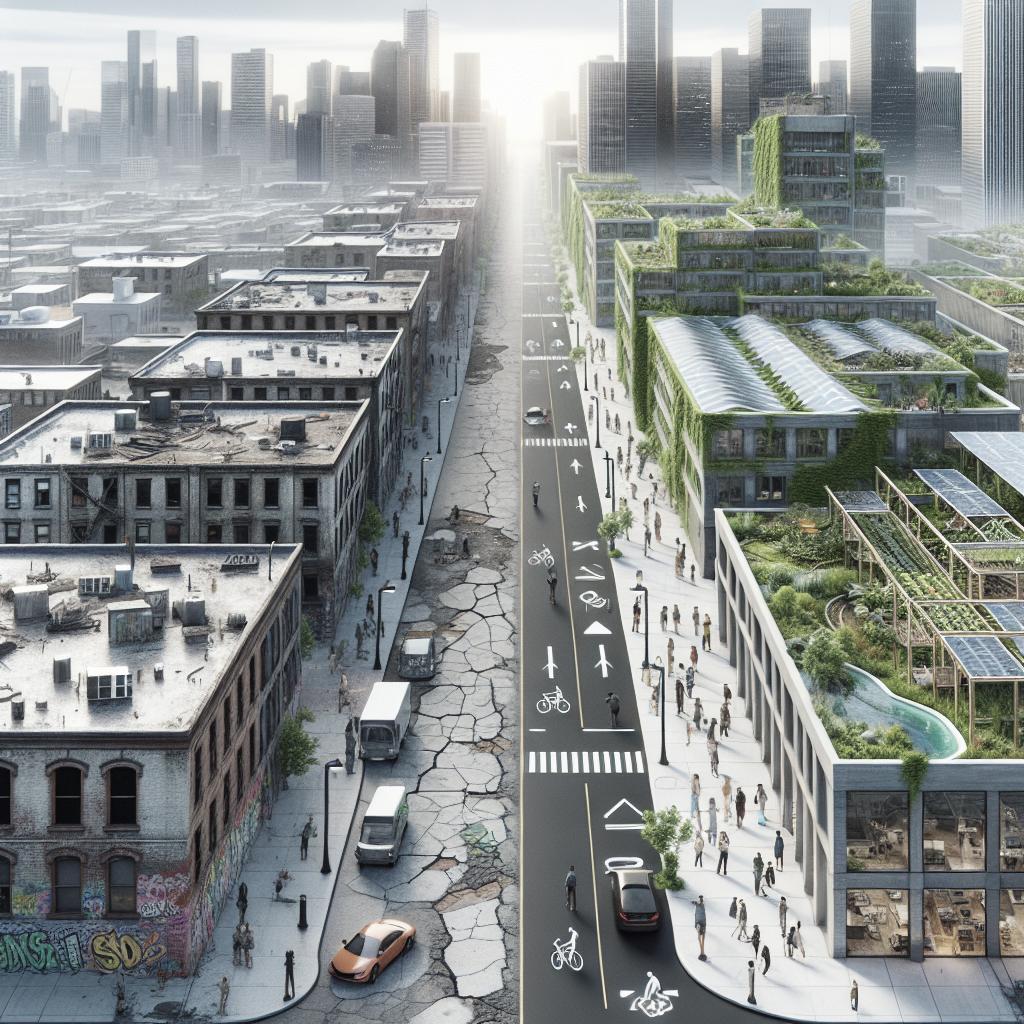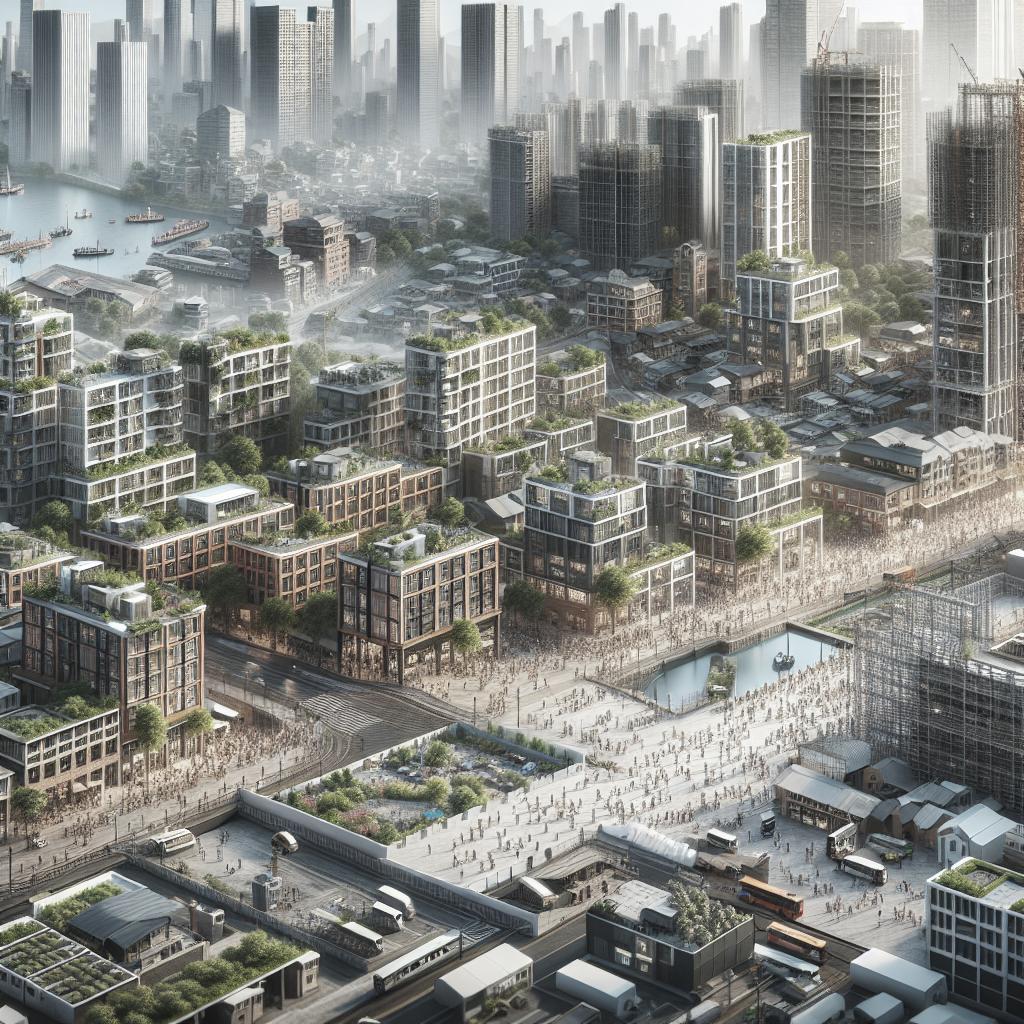<>
Urban redevelopment is an essential process that aims to revitalize and future-proof our cities. However, it requires meticulous planning and execution to ensure that redevelopment efforts meet the needs of diverse communities, are economically sustainable, and align with long-term urban visions. This blog post will delve into the best practices for urban redevelopment, covering essential topics such as creating shared value, engaging stakeholders, establishing development goals, and incorporating local culture. Additionally, we’ll explore related aspects of green infrastructure, the financial implications of soil cells, and various methods to manage urban trees. By following these best practices, urban planners and developers can create thriving, resilient urban environments for current and future generations.
1. Create “Shared Value”
Creating “shared value” is a concept that integrates social progress with economic gains, ensuring that urban redevelopment benefits all stakeholders. When businesses and communities work together, the outcomes can enhance economic performance while simultaneously addressing societal issues. Developers should, therefore, seek to create projects that deliver economic profits and improve the quality of life for residents. One way to create shared value is through mixed-use developments. These projects combine residential, commercial, and recreational spaces to maximize land utility and improve accessibility to essential services. By integrating different functions into a single project, developers can foster a more vibrant and cohesive community. Additionally, shared spaces such as parks and community centers provide communal areas for social interaction, contributing to social cohesion.
2. Plan With Input From All
Inclusive planning ensures that the voices of all stakeholders, including residents, businesses, and community organizations, are heard. This multi-faceted approach helps create development plans that reflect the diverse needs and aspirations of the community. Engaging stakeholders from the outset can also build trust and foster a sense of ownership among community members. Public meetings, focus groups, and surveys are effective tools for gathering input. These methods allow developers to collect a wide range of perspectives and address any concerns early in the planning process. Moreover, involving the community can uncover innovative ideas and solutions that developers might not have otherwise considered. Transparent communication throughout the project’s lifecycle is critical to keep stakeholders informed and engaged.
3. Build a Long-Term Vision
A long-term vision for urban redevelopment ensures that the projects are sustainable and adaptive to future changes. A well-articulated vision provides a roadmap guiding short-term actions and decision-making, aligning them with broader, long-term goals such as sustainability, resilience, and social equity. Long-term visioning should consider global and local trends, demographic shifts, and technological advancements. Scenario planning can be used to envision different futures and prepare flexibly for various outcomes. Stakeholders should revisit and revise the vision periodically to ensure it remains relevant and reflective of changing circumstances. Embedding this long-term perspective into every facet of the planning process helps create resilient urban environments.
4. Agree on Non-Negotiables
Identifying and agreeing upon non-negotiables or key priorities is crucial during the planning stages. These may include preserving historical landmarks, ensuring affordable housing, or maintaining green spaces. By setting these non-negotiable elements early on, developers can avoid conflicts and ensure that the project remains true to its core values. Non-negotiables act as guiding principles throughout the redevelopment process, ensuring that essential aspects of the project are preserved and respected. They provide a clear framework for decision-making and can help resolve disputes among stakeholders. Open discussions and consensus-building activities can help establish these priorities and reinforce their importance.
5. Agree on a Financial Profile
Successful urban redevelopment requires a sound financial foundation. Developers and stakeholders must agree on a financial profile that outlines funding sources, budget allocations, and potential revenue streams. This financial strategy should align with the overall objectives of the redevelopment project and ensure its economic viability. Developing a comprehensive financial profile involves detailed cost analyses, risk assessments, and identification of funding opportunities such as public-private partnerships, grants, and loans. It is essential to maintain transparency and accountability in financial matters to build trust among stakeholders and attract investment. Regular financial reviews and updates help keep the project on track and address any financial challenges promptly.
6. Establish Clear Development Goals
Clear development goals are necessary to guide the redevelopment process and measure progress. These goals should be specific, measurable, achievable, relevant, and time-bound (SMART). Establishing clear objectives helps keep the project focused and ensures that all stakeholders are aligned. Development goals might include increasing affordable housing, improving public transportation, or enhancing green spaces. These targets should reflect the community’s needs and the long-term vision for the redevelopment area. Regular monitoring and evaluation of these goals can help identify areas for improvement and ensure that the project is on course to achieve its intended outcomes.
7. Establish Options to Achieve Development Goals
Once clear development goals are established, it’s essential to develop various strategies or options to achieve them. These options should consider different approaches, resources, and timelines to provide flexibility. By exploring multiple pathways, developers can identify the most effective and efficient methods for achieving their objectives. Scenario planning and feasibility studies are valuable tools in this phase. They allow stakeholders to assess the potential impacts and benefits of different approaches. Engaging with a broad range of experts, including urban planners, architects, and economists, can provide insights and innovative ideas to enhance the redevelopment process.
8. Incorporate a Sense of “Localness”
Incorporating a sense of “localness” ensures that redevelopment efforts complement and enhance the existing character and culture of the area. This approach fosters a unique identity and strengthens community ties. Developers should consider local architecture, historical contexts, and cultural traditions when designing and implementing redevelopment projects. Utilizing local materials and collaborating with local artists can help create spaces reflecting the community’s unique identity. Public art installations, local markets, and cultural festivals can celebrate and preserve the area’s heritage. By honoring the local context, developers can create authentic and vibrant urban spaces that resonate with residents and visitors.
9. Evaluate Options With the Goal of Maximizing Net Community Benefits
When assessing various redevelopment options, the primary focus should be on maximizing net community benefits. This involves evaluating the social, economic, and environmental impacts of each option to determine the overall value it brings to the community. A holistic approach ensures that redevelopment efforts contribute positively to all aspects of urban life. Cost-benefit analyses, social impact assessments, and environmental evaluations are essential tools in this process. These methods allow stakeholders to quantify and compare the potential outcomes of different redevelopment strategies. By prioritizing options that offer the greatest net benefits, developers can enhance community well-being and sustainability.
10. Align the Procurement Model With the Planning Vision
Aligning the procurement model with the planning vision ensures that resources are effectively utilized to achieve the desired outcomes. The procurement process should reflect the project’s values and goals, selecting partners and suppliers who share the same commitment to quality, sustainability, and community engagement. Transparent and competitive procurement practices can attract high-quality contractors and suppliers. Incorporating criteria such as sustainability certifications and local sourcing can further align procurement with the project’s vision. Regular audits and performance evaluations help ensure accountability and continuous improvement in the procurement process.
Search Posts
Is Green Infrastructure Expensive?
The initial costs of green infrastructure might seem high, but the long-term financial and environmental benefits often outweigh these expenses. Sustainable practices, such as green roofs and permeable pavements, reduce maintenance and operational costs over time.
How Much Do Soil Cells Cost?
Soil cells, essential for supporting urban trees, vary in cost depending on the size and specific requirements of the project. Investing in high-quality soil cells can lead to healthier trees and reduced maintenance costs in the long run.
How Urban Trees Prevent Flooding
Urban trees play a crucial role in managing stormwater by intercepting rainfall, reducing runoff, and enhancing soil infiltration. Properly planned urban forestry can help mitigate flood risks and improve water quality.
How to Increase Tree Canopy Cover in Cities?
Increasing urban tree canopy requires strategic planning, including selecting suitable tree species, proper planting techniques, and ongoing maintenance. Community engagement and public education are also vital for successful urban forestry initiatives.
How to Build Resilient Cities with Green Infrastructure
Incorporating green infrastructure, such as parks, green roofs, and urban wetlands, enhances urban resilience by mitigating climate risks, improving air quality, and promoting biodiversity. These practices contribute to healthier, more sustainable cities.
How to Stop Pavement Lift from Tree Roots
Innovative techniques like flexible pavements, root barriers, and soil cells can prevent tree roots from lifting and damaging urban pavements. These methods allow trees and infrastructure to coexist harmoniously.
How Landscape Architects Plant Trees in Cities
Landscape architects employ various techniques, such as selecting appropriate tree species, ensuring adequate soil volume, and designing for water management, to successfully plant and maintain urban trees.
The Ultimate Guide on How to Plant Urban Trees
This comprehensive guide covers everything from selecting the right tree species to proper planting techniques and ongoing care, ensuring successful urban tree planting projects.
Right Tree, Right Place
Choosing the appropriate tree species for a specific urban environment is crucial. Factors such as soil conditions, climate, and available space must be considered to ensure long-term tree health and compatibility with urban infrastructure.
Why the Stratacell is made of Recycled Plastic
Stratacells, used to support urban trees, are made from recycled plastic to reduce environmental impact. This sustainable choice aligns with broader goals of reducing waste and promoting circular economy practices.
Natural Water Harvesting
Natural water harvesting techniques, such as rain gardens and bioswales, capture and manage stormwater, reducing runoff and improving water quality. These methods are integral to sustainable urban water management.
| Best Practice | Description |
|---|---|
| Create “Shared Value” | Integrates social progress with economic gains, benefiting all stakeholders. |
| Plan With Input From All | Involves all stakeholders in the planning process to ensure diverse needs are met. |
| Build a Long-Term Vision | Creates a sustainable roadmap guiding the redevelopment process. |
| Agree on Non-Negotiables | Establishes key priorities to avoid conflicts and preserve core values. |
| Agree on a Financial Profile | Outlines funding sources, budget allocations, and revenue streams for economic viability. |
| Establish Clear Development Goals | Defines specific, measurable, and achievable objectives for the project. |
| Establish Options to Achieve Development Goals | Explores multiple strategies to provide flexibility in achieving objectives. |
| Incorporate a Sense of “Localness” | Ensures redevelopment complements and enhances local culture and character. |
| Evaluate Options With the Goal of Maximizing Net Community Benefits | Assesses social, economic, and environmental impacts to maximize overall community value. |
| Align the Procurement Model With the Planning Vision | Selects partners and suppliers who share the project’s commitment to quality and sustainability. |


